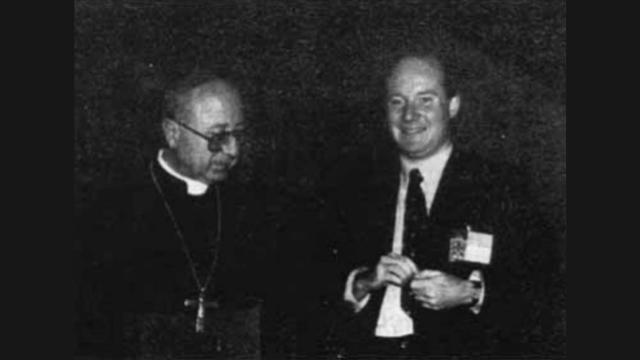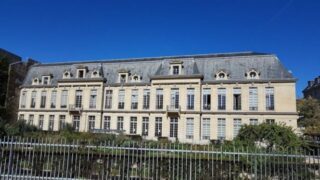The Italian prelate died shortly before his 100th birthday. He was a larger-than-life figure, whose ideas on new religious movements still deserve to be studied.
by Massimo Introvigne


I learned from Italian media discussing the death on July 16 of a famous Italian bishop, Luigi Bettazzi, shortly before he turned 100, that another Italian bishop who would soon turn 100, Giuseppe Casale, had died on May 18, 2023. I had missed the news. He had lived his last years hosted by a nuns’ convent in Vallo della Lucania, and I had somewhat lost contact with him. Hence this belated obituary, giving Archbishop Casale his due as the first president of CESNUR, the Center for Studies on New Religions, from 1988 to 1996.
Giuseppe Casale was born in the historical city of Trani, in the Italian province of Bari, on September 28, 1923. He studied philosophy and theology under the difficult conditions of World War II and was ordained a priest on February 3, 1946. In 1949, he became a professor of Church History, a matter he taught until 1953 and continued to study throughout all his life. In 1955, he was appointed Deputy National Assistant to the Youth Division of the Italian Catholic Action, a position he maintained until 1964. In the 1960s and 1970s, he served in various national Catholic commissions as an expert of both Church History and the problems of young students and workers.
On October 26, 1974, Pope Paul VI appointed him as bishop of the small diocese of Vallo della Lucania, in the province of Salerno. As a Southern bishop with a background as a historian, he was both aware of and interested in the progress of Pentecostals and Jehovah’s Witnesses in his territory, and gradually started following the international debates on new religious movements. This is why he asked to meet me, and later other international scholars of new religious movements, including Jean-François Mayer, Eileen Barker, and J. Gordon Melton.
We organized a small conference in 1988 in Vallo della Lucania, which we somewhat ambitiously called the first conference of a newly established CESNUR, the Center for Studies on New Religions, although less than twenty were in attendance. Casale very much insisted that he did not want to establish a Catholic organization but a scholarly one, and was very happy to have a non-Catholic, Jean-François Mayer, among the small group of speakers at the conference and co-founders of CESNUR. Actually, the most exciting event at that conference was that, while we were in Vallo della Lucania, news came that Bishop Casale had been promoted archbishop on May 7, 1988, and would serve in a much larger Southern Italian diocese, Foggia and Bovino.
This was the reason why 1988 was the only year in which CESNUR had two conferences, one in Vallo della Lucania, and one in Foggia, to celebrate the new prestigious appointment of a bishop we had elected as the first president of our organization (Eileen Barker and Gordon Melton also attended the Foggia conference).
Although very busy as the archbishop of a large diocese, Casale continued to be interested in new religious movements and CESNUR, attended several of our international conferences, and met with board members periodically. He also commissioned and financed a research on all religious minorities active in the province of Foggia, which was later published in 1997 as “Il gigante invisibile” (The Invisible Giant, Foggia: NED), edited by myself and by Turin University sociologist Luigi Berzano.
New religious movements were not the only controversial subject Archbishop Casale involved himself in. As I can personally testify, he had an encyclopedic knowledge of Italian organized crime. He bravely denounced Catholic priests who protected organized crime bosses or accepted gifts from them. At one stage, the Italian police had to persuade him to leave his apartment in the diocese only accompanied by bodyguards.


He was favorable to the appointment of female Catholic cardinals and to the blessing in Catholic churches of same-sex unions and was what one would call in general an extremely liberal bishop. I did not agree with all his positions, but this only made our conversations more lively and memorable. We spent long hours of the evening and night during my visits to Foggia, where I would normally stay in the Archbishop’s apartment, discussing politics, religion, and pretty much everything, with Casale’s sister periodically and silently appearing to offer an incredible variety of local cookies and beverages. Later, Luigi Berzano became also part of these lengthy domestic conversations.
In 1996, Casale resigned from president of CESNUR, and was replaced by Berzano, with the undersigned continuing as managing director. He was simply too busy with his diocese, and was also getting older. On May 27, 1999, he also resigned from his position as Archbishop of Foggia, although his opinions on various matters continued to be frequently sought by Italian media well into the new century.
It was precisely because of his natural empathy with all sort of discriminated minorities that Casale also understood the injustices vested on new religious movements. He was critical both of the secular anti-cult movement and of some excesses of Catholic counter-cultists. He remained, however, firstly a Roman Catholic bishop, something members of new religious movements captivated by his natural sympathy and Southern Italian humor, and hoping for more support, sometimes risked to forget.
His feelings and ideas about new religious movements emerge from his pastoral letter “New Religiosity and New Evangelization” issued in 1993 (and reprinted as a book by a national publisher, Piemme of Casale Monferrato, in the same year). The 100-page pastoral letter remains a unique document in the history of the Catholic approach to new religious movements.


Casale mentioned the work of CESNUR and Pope John Paul II’s concept of “new evangelization” of Europe, a continent that had been de-Christianized and was in need of a new Catholic missionary effort. With words that will be precious today if some bishops in the Russian Orthodox Church would read and apply them to their own situation, Casale denied that the growth of religious movements was a significant cause of the decline of the number of active Catholics in Italy and Europe. Although a few groups, first among them the Jehovah’s Witnesses, had a noteworthy development, Casale noted that statistics failed to support any theory attributing to the new religious movements a main responsibility in the Catholic decline. The Catholic Church had lost a much greater number of active members than the one we could arrive at by summing up the devotees of all new religious movements.
Much more dangerous than the new religious movements was for Casale what he called “new religiosity” and mentioned in the title of his letter: a set of religious and magical beliefs, sometimes (but not always) connected with the “New Age,’” which were embraced by many, were incompatible with the Catholic faith, and were subtly eroding it. Many who still called themselves Catholics had in fact joined their personal do-it-yourself religion.
Casale then proceeded to analyze some reactions to the emergence of both the new religious movements and the “new religiosity” he regarded as wrong. The first was the “secular ideology” of the “anti-cult movement,” which often reduced religion to its psychological dimension. The Archbishop warned Catholics against lending their support to “the laws that the ‘anti-cult movements’ propose,” which would in fact ban all religious experiences that are “too intense” for the modern secular taste. These laws, Casale wrote, are “dangerous” for religious liberty—and for Catholics, too “because there is a very practical risk that modern states, largely secularized, may judge as ‘too intense’ even religious experiences that are located within the ‘old’ religions rather than the ‘new.’ The vehement attacks that the best-known ‘anti-cult movements’ in the United States have brought against Opus Dei and other well-respected Catholic institutions […] have already demonstrated that the danger is not purely theoretical.” Casale also condemned the practice of deprogramming as “never acceptable and contrary to Catholic morals.”
Another inadequate answer to new religious movements and “new religiosity” came, the Archbishop wrote, from the Christian “counter-cult movement,” whose origins were Protestant-Evangelical. While Catholics do believe in the existence of the Devil, Casale recommended that they should not accept the naive “demonological explanations” of the emergence of the new religions advanced by certain conservative Evangelicals. Catholic counter-cultists also sometimes focused almost exclusively on new religious movements they labeled as “cults,” while the Archbishop regarded “new religiosity” as a more serious problem.
Casale recommended to regard new religious movements and the “new religiosity” as a “challenge” rather than as an enemy or a competitor, and indeed “challenge” is one of the most recurring words in the letter. There was a theological challenge for Catholics in some popular ideas of the “new religiosity” and others spread by the most successful new religious movements, particularly on the themes of the afterlife and eschatology in general. It is neither against religious liberty nor interreligious civility, Casale argued, that Catholic theologians criticize what for the Catholic Church are deviations from the orthodoxy, and priests warn Catholics against them.
At the same time, using “challenge” as the main interpretive category meant trying to understand the reasons and needs that led many Catholics to embrace “unorthodox” beliefs, the Archbishop added. Sometimes, they would be found in shortcomings of the Catholic Church itself and in an uninspiring presentation of its doctrines. The needed “vigilance” should thus be accompanied by an “openness” and a cautious dialogue extended also to new religious movements.
Casale’s 1993 text was a pastoral letter, which is a specific genre in Catholic literature. A pastoral letter is an official document of instructions from a bishop to his flock. It is not a scholarly article nor a merely theoretical dissertation.
Read for what it was, the letter maintains a surprising freshness after thirty years from its publication. It also testifies to the great sensitivity and humanity of Archbishop Casale, a man of strong opinions and at the same time of a surprisingly gentle conversation. He had a long and fruitful life, and will be missed by his many admirers and friends.








